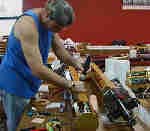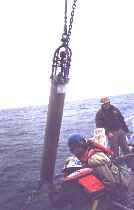
Traveling worldwide, the Ronald H. Brown is a multipurpose research vessel capable of supporting both oceanographic and atmospheric research. It is the vessel we will be using for the Pioneer Seamount expedition. Click image for larger view.
Staging the Mission
August 17, 2001
Chris Fox, Director
Acoustic Monitoring Project
NOAA Pacific Marine Environmental Laboratory
Planning an oceanographic expedition begins at least a year, and sometimes several years, in advance of the actual sailing. First, the Principal Investigator must obtain research funding and approval for the project. Next, the planned expedition must be pooled with other expeditions and fit into the ship schedules of the oceanographic fleet, which includes ships from NOAA, universities, other agencies, and commercial contractors. The selected ship must be capable of performing the operations required and available in the right location at the proper time of year. Since the Sound in the Sea expedition to Pioneer Seamount involves raising a seafloor cable on deck and working on it for several days, a ship with heavy lift capabilities and the ability to hold its position for extended periods was required. The ship must also be available on the U.S. West Coast during the summer season, since winter storms could be disastrous to the mission if they arrived while the cable is on deck. Fortunately, the NOAA Ship Ronald H. Brown, a large (Class 1) oceanographic vessel with heavy winches and A-frame and Dynamic Positioning System, had planned a transit from Seattle to San Diego in August, 2001 so that the extra days for the Pioneer Seamount work could be scheduled without a large disruption of the other missions of the ship.

Matt Fowler assembles a PMEL autonomous hydrophone in our laboratory in Newport, Oregon.
After an appropriate ship is found, the detailed expedition planning begins. In the case of NOAA ships, this process begins with the Cruise Instruction document, which is the only official correspondence between the ship and the scientific party. This report is produced by the Chief Scientist (usually the Principal Investigator) and informs the ship’s personnel exactly what operations will be conducted and what will be expected of the ship. Included in the report are the names and affiliations of all scientific party members, the nature of the equipment being brought on board, including weights, special handling and provisions for hazardous materials, and a detailed description and time table for planned operations. The process is iterative: a draft plan is sent to the ship, they return questions and concerns, a new draft is submitted, and this process continues until a final cruise plan is derived. Expeditions vary greatly in complexity, depending on the number of different experiments being conducted. In the final phase of cruise staging, equipment is transferred to the ship (called mobilization), scientific personnel are brought onboard at the planned date and location, and the expedition gets underway.

The PMEL moored autonomous hydrophones are deployed off the aft deck of the NOAA vessel Ron Brown.
The Sound in the Sea Pioneer Seamount Expedition is relatively straightforward. The Ron Brown will be available for loading in Seattle for several weeks before departure on August 27, 2001. The equipment for the cable work will be loaded there from its home at the University of Washington Applied Physics Laboratory (UW/APL). The ship will then transit to San Francisco, where most of the scientific party will board in a short “touch and go” on August 30, and proceed to Pioneer Seamount in a six hour transit. On reaching the site of the cable termination, UW/APL engineers will first interrogate the acoustic release which is attached to a float and retrieval line on the cable junction box, and release the float. After grappling the float and retrieving the recovery line, the junction box will be hauled on deck and the ship placed in as small a watch circle as possible (using the dynamic positioning system) for 24-48 hours while engineers work on the cable termination and attach the hydrophone array for redeployment. While this work is being done on the ship, NOAA and UW/APL engineers will be working at the shoreside terminus of the cable at Pillar Point Air Force Station to evaluate the signal levels of the cable and set up the data communications links for transmitting the acoustic signals to the NOAA/PMEL laboratory in Newport, Oregon, where they will be analyzed. The cable, junction box, hydrophone array, and recovery package will be redeployed and the location of the junction box located using acoustic techniques. The ship will then transit to San Diego for debarkation of most of the scientific party and removal of the remaining equipment.
As with most expeditions, there are a few “piggyback” operations on the expedition. The team has been asked to conduct some tests of the ship’s bathymetric sonar enroute from Seattle. These test consist of running the ship over a sloping seafloor in several different directions to look for errors in the results. Also, the expedition that will use the ship after our cruise, EPIC or Eastern Pacific Investigations of Climate, plans to put their engineers onboard in Seattle to set up and test instruments, in particular advanced radar systems, before boarding the main scientific party in San Diego. Finally, the TAO program (Tropical Atmosphere and Ocean) requires a significant amount of equipment to be loaded in Seattle to save the costs and difficulty of shipping the gear to Chile, where their scientific party will meet the ship. The planned number of participants is about 28, including the Chief Scientist, four scientists/engineers from University of Washington for the Pioneer cable work, one bathymetric sonar specialist, ten EPIC program scientists, and a group of observers from the Ocean Exploration office. One can see that although the expedition to Pioneer Seamount is only 2-3 days in length, the planning and execution requires months of effort by the participants to be successful.
Sign up for the Ocean Explorer E-mail Update List.









